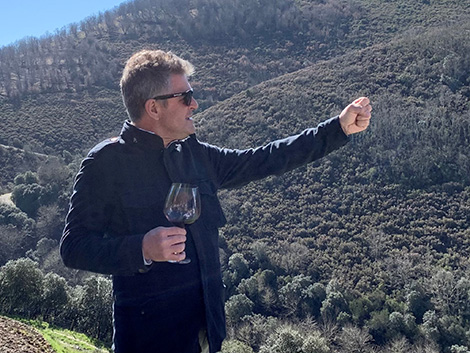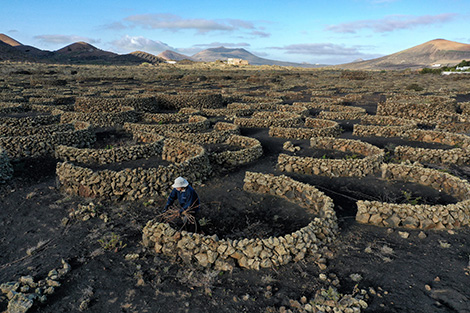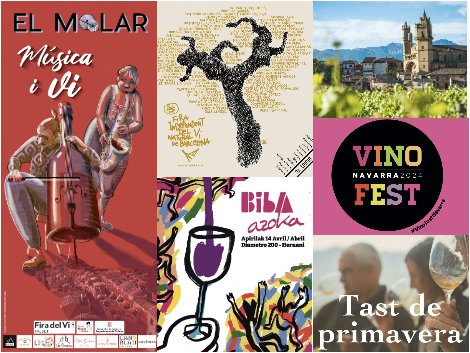Celebrating 25 years in Corullón and tasting en primeur with Álvaro Palacios

The en primeur tasting of Álvaro Palacios' 2023, held earlier this month in Corullón (León), had a festive atmosphere. Not only did it mark the 25th anniversary of the founding of Descendientes de J. Palacios, the estate created by the Rioja star producer with his nephew Ricardo Pérez in Bierzo in 1999, but it also heralded the debut of his daughter Lola, aged 26. After extensive international training -she has lived abroad since she was 14- Lola joined the family business in January this year. The event was also an opportunity to taste some promising 2023 reds.
The goblet-trained vines on the steep slopes next to the state-of-the-art winery basked in sunshine and clear skies. Only the snow on the highest peaks was a reminder of the severe storm that had hit the area in the previous days.
The event began with a walk to Las Lamas, where Ricardo Pérez Palacios (pictured below) commented on the convergence of Atlantic and Mediterranean influences in the area, evidenced by the striking differences in vegetation between the northern slope, covered with chestnut and broom, and the southern slope, full of rock roses, holm oaks and vineyards. A youthful Las Lamas 2015 accompanied the explanation. Although it was considered a ripe vintage at the time, it was a world away from the hot weather of recent harvests. The distinctive red berry fruit expression of this site came through with purity and focus. The greater amount of clay amongst the slate at Las Lamas results in an enveloping, exuberant character. With its freshness and power, this 2015 seemed far from its peak.

You can read about the history of Descendientes de J. Palacios in this article published in SWL in 2016. At that time, the wines were still being made in Villafranca del Bierzo, while Rafael Moneo's spacious winery, which dives 20 metres into the mountain, was still under construction.
The en primeur tasting of the 2023 vintage of Descendientes de J. Palacios and Alvaro Palacios's two other estates in Rioja and Priorat was held in the ageing cellar, overlooking the Precambrian schist beneath the Moncerbal site.
The next generation
There we had the chance to talk to Lola, 26, who is getting to know the different areas of the business. Since joining the company, Lola has shadowed her father, who has just turned 60 but looks as energetic as ever, around vineyards, wineries and on trips in Spain and abroad - she attended a presentation at the 67 Pall Mall Club in London last February.
Lola admits that she prefers viticulture to numbers. One of her most memorable vineyard experiences was at Jean-Louis Chave in the Rhône ("I found it all so authentic and real"). When she was a teenager studying in the United States and returning to Spain for the summers, she complained about having to work in the vineyards while her friends enjoyed their holidays, but now she feels deeply attached to the land.
She speaks fluent English and French and has trained with the best producers. In addition to Chave, these include Romanée Conti, Pingus, Clos de Tart, Le Pin and Harlan in Napa Valley. When she had to move from viticulture to winemaking in Napa, she did not hesitate to choose Promontory, the estate with less oak influence in the group, as they prefer foudres to barrels.
Lola accompanied her father and Ricardo throughout the day, but refrained from speaking in public. "I want what I say to be real," she explained. It was clear that she enjoys a close relationship with her father and shares his passion for music and flamenco. She also seemed comfortable with the attention being paid to her. When I asked her to pose for a photograph, she graciously obliged, displaying the natural ease so characteristic of her generation.

Al Chelo, a new single vineyard from Bierzo
Ricardo Pérez reminded the audience that Mencía's reductive winemaking style put the Bierzo wines at a disadvantage against Rioja and Priorat, which tend to be more open and expressive at this stage. Some of his reds, particularly Corullón, the new Al Chelo and La Faraona, did show some reduction on the nose, but on the palate they had good definition.
2023 was a year of intensive vineyard work. The wettest months of the growing season were June and September, resulting respectively in a higher risk of mildew and a lot of sorting in the vineyard. Thanks to generous water reserves over the winter, rainfall was close to 900 mm. Temperatures were above average in April, May and especially August, with a severe heatwave at the end of the month. According to the Descendientes harvest report, they had "good yields, but with small clusters and medium-sized berries."
All the wines have some white grapes in the blend, ranging from 10% in the case of Corullón and Las Lamas to 2% for La Faraona. In Corullón (just over 35,000 bottles) we found plenty of flavour and rich, sweet fruit, with slightly herbaceous tannins ( it usually includes some stems for fermentation) that have plenty of time to integrate into the wine. Although somewhat closed on the nose, Moncerbal (6,400 bottles in this vintage) was superb: juicy, sapid, with an unmistakable mineral background, firm tannins, yet bright and almost aerial. Las Lamas (6,000 bottles this vintage) showed the most expressive nose. A fine, well defined red, with red berry and herbal notes; full on the palate, with almost polished tannins and remarkable length.

The new Al Chelo (what a happy coincidence that the vineyard's name is the same as Chelo Palacios, Ricardo's mother and Álvaro's sister, who died in 2021) was more concentrated, with dark fruit and earthy tannins, although it was the most restrained of the series. The grapes come from a 0.30 ha vineyard in the Valdafoz site, which used to be destined for Corullón. Only 1,000 bottles will be produced in this first vintage. Lastly, La Faraona (of which 1,200 bottles will be produced in 2023) stood out for its liveliness and nerve, with an outstanding herbaceous quality, strong character and remarkable freshness.
A parade of vintages
The lunch that followed, prepared by chef Nacho Manzano of the two-star Casa Marcial restaurant, was paired with past vintages from all three wineries, with Bierzo taking the lion's share on its 25th anniversary.
We had the opportunity to compare Corullón 2012 and 2018, two vintages that Ricardo Pérez considers to be a good combination of Atlantic and Mediterranean influences. The 2018, still very young and pale in colour, showed crunchy forest fruit and delivered consistency, tension and plenty of freshness on the palate. The 2012 was on a different level of complexity with nuanced fruit, meaty notes reminiscent of the Rhône and dried flowers. It showed depth, volume and length and was very much alive and kicking. If you have a bottle in your cellar, consider yourself lucky.
As for Moncerbal, which according to Pérez is at its best in cold, wet years, two Atlantic vintages were selected. The juicy, delicious 2021, with its distinctly sapid character, must be one of the most promising of all the wines tasted. And what a nose: spices (black and pink pepper), citrus (blood orange) and fine herbal notes. The cold, rainy 2013 was almost reminiscent of Galician reds, with aromas of forest and fallen leaves, the freshness of the stems, black pepper and mineral saltiness on the finish. It also had a dark, deep, rather mysterious quality. After tasting these bottles, one cannot help but feel a bit "moncerbalist".

For Las Lamas, on the other hand, more mature vintages were selected. The 2019 started with sweet notes reminiscent of toffee, then evolved towards red fruit and herbal notes. The palate was fuller and more opulent, yet refreshing, with great aromatic intensity and length. The 2012 was more powerful and structured, evolving into dark fruit notes and perhaps a little less expressive. Interestingly, the 2012 Corullón showed more complexity as it had reached its full potential.
In the case of La Faraona, the choice was between an Atlantic, rather wet vintage (2014) and the 2018 with some Mediterranean influence. More impressive, perhaps, might be the fact that both were awarded 100 points by Luis Gutiérrez, The Wine Advocate's critic for Spain. La Faraona is Descendientes de J. Palacios' highest vineyard. It is a rectangular strip of 0.55 ha rising to 900 m on a steep slope on the El Fierro site in Corullón. It is clearly visible from the winery and has the peculiarity of being crossed by a small tectonic fault. Both vintages showed the liveliness, the herbal, crisp character and the somewhat restrained fruit that characterises the plot. The 2018 vintage shone more brightly in my glass than the 2014, so intensely aromatic (can I say propulsive?) and lively, fine and precisely defined, still youthful and with a lot of life ahead of it.

A major surprise in Priorat
The paradox of the tasting was to find fresh, expressive wines in the driest of vintages. Less than 230 litres were recorded in Gratallops and only 43 litres in a season as important for rainfall as spring. For the first time, Álvaro decided to use irrigation in the vineyards with very rocky soils and on the top of the hills, where the shallow soils are very susceptible to erosion. He also strengthened the vineyard team to be able to work almost vine by vine. Interestingly, September was the wettest month of the 2023 growing season, with 80 litres of rain recorded at Les Aubaguetes and 51 at L'Ermita.
Under these circumstances, how could the 2023 Gratallops Vi de Vila (13,730 bottles) possibly display such tension? With an almost perfect combination of Garnacha's sweet fruit and Cariñena's punch (20%), the wine showed floral complexity and polished, elegant tannins. This has to be one of the smartest buys of Álvaro Palacio's 2023 en primeur.
There were more pleasant surprises to come. Like the delicate Finca Dofí (28,000 bottles), made from 95% Garnacha, with notes of citrus, violets and pink pepper. The palate was well-balanced, savoury and subtle. In La Baixada (3,460 bottles), a plot formerly destined for Dofí (some of which still goes into the blend) but produced separately since 2018, the emphasis is on Garnacha, although it also contains 5% Garnacha Blanca. The delicate nose, with hints of sweet red fruits, gave way to an aromatic, juicy and long palate. It was hard to believe that it could taste so fresh.

Les Aubaguetes (1,200 bottles) and L'Ermita (4,800 bottles) are made from a larger blend of grape varieties. The only one not in Gratallops, Les Aubaguetes is a 1.79 ha, 123-year-old plot in Bellmunt del Priorat that combines 60% Garnacha, 35% Cariñena and 5% white varieties (Garnacha Blanca and Macabeo). Along with aromas of red and blue fruits, it has a suggestive honeyed character, reminiscent of white flowers. It showed good concentration, but remained fresh and juicy on the palate, with fine tannins and remarkable length. The coveted L'Ermita went a step further in terms of subtlety, with aromas of talcum powder, flower petals and hints of orange peel. It showed purity of flavour, aromatic depth and finesse. This vintage's blend consists of 84% Garnacha, 13% Cariñena, 2% Picapoll and 1% white grapes.
Winemaker Oriol Castells told us that, in the search for freshness, stems have become a common part of the fermentation process, but they aren't obvious, probably due to the round texture of the tannins. It is difficult to estimate the ageing potential of wines that are already so elegant and expressive. However, it is to their credit that they have preserved the freshest and most subtle nuances of a vintage that, due to the cumulative drought, has threatened the very existence of the Priorat vine.
A new release in Rioja: Valdelareina
Last week we published on our social media that there was a new single vineyard from Rioja. Valdelareina comes from a 1.4 ha plot at 700 m elevation (Quiñón de Valmira is at 616 m.), with reddish soil rich in clay. A limited edition of 3,700 bottles will be released for around €250, a lower price than its sibling. The nose is complex and rich in nuances with blood orange, hints of violet, a touch of cherry and a fresh herbal background. The palate offers more of the herbal side, savoury and with good fruit concentration, firm tannins and a hint of green pepper on the finish. It will be interesting to see how it develops in the bottle.

Quiñón de Valmira (4,190 bottles in this vintage) was very expressive and mouth-coating, while retaining a somewhat ethereal quality on the palate. It started with a lot of fruit, reminiscent of tangerine and red berries, then enhanced with aromas of Mediterranean herbs. The palate was really deep, with round, well wrapped tannins, remarkable balance and persistence. Garnacha is blended with 15% of other varieties. The vineyard has characteristic shallow soils, with calcareous and ferruginous clay colluvial deposits on a deep, cold stone-limestone bedrock.

Amaya Cervera
A wine journalist with almost 30 years' experience, she is the founder of the award-winning Spanish Wine Lover website. In 2023, she won the National Gastronomy Award for Gastronomic Communication
Wine tastings in April 2024
NEWSLETTER
Join our community of Spanish wine lovers






